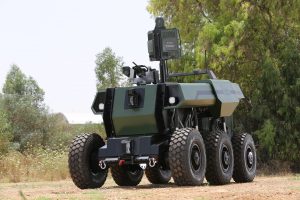US military looking to buy Israeli bots for infantry operations
Breaking Defense:
These vehicles could be a force multiplier for infantry operations and also create an ability to move to contact much quicker and safer. They are an extension of the technology that was created for drone operations.
There is more.The US Army is looking into robots designed by Israel Aerospace Industries, with the first contracts likely to be signed in early 2019, after which production will shift to IAI’s US subsidiaries.
In recent months top officials of the US Tank-Automotive Research, Development & Engineering Center (TARDEC) have been visiting IAI facilities almost on a weekly basis, Breaking Defense has learned.
TARDEC, soon to be part of the new Army Futures Command, is exploring a wide range of IAI robotic systems, Shamni said: counter-IED bots to handle roadside bombs; robotic mules to follow infantry soldiers with extra supplies; “leader-follower” systems where manned vehicles lead unmanned ones in convoy; engineering robots to bulldoze obstacles under fire; optionally manned vehicles that can switch to unmanned operation “in seconds”; and even armed robots. All these systems, he said, can either be remotely controlled by human operators or switch into a fully autonomous mode where they make decisions based on what their sensors see and what instructions the humans gave them before the mission.
But IAI is already looking into the next generation: “flocks” or swarms of robotic systems that communicate with each other using Internet Of Things (IOT) technology and collaborate to accomplish their mission. The US Army and other potential users want robots that can react in real time to immediate threats, Shamni said: “This requires operational decisions to be made in the front line and not in remote command centers, (using) robotic systems that are interconnected and can assist each other (in) fast changing conditions.”
Already, Shamni said, IAI is designing many of its ground robots to work with or even launch its combat-tested mini-drones and loitering munitions such as Harop (Harpy) and Green Dragon. With such robotic technologies likely to be be implemented on a “massive” scale, he said, “it opens operational opportunities that are now considered a wild dream.”
One of the largest is the seven-ton, six-wheel RoBattle – an unmanned, heavy-duty, highly maneuverable robotic vehicle designed to support foot troops in a wide range of missions, including armed reconnaissance, convoy protection, decoy operations, ambush, and attack.. Operators can equip RoBattle with different payloads including manipulator arms, sensors such as radars, and remotely controlled weapons. There’s even an option to replace the wheels with tracks. Overall, the 14,000 pound vehicle can carry up to 6,000 pounds of mission-specific equipment or cargo.
Robattle currently communicates with its human overseers using 4G LTE cellular technology, although the US might rather install a military-specific communication kit that’s more resistant to jamming.
Another, smaller infantry support robot is the REX, currently under evaluation by both the Israeli and Australian armies. Shamni — a former paratrooper and IDF chief of infantry himself — noted that the modern infantryman must carry body armor, ammunition, and a wide array of electronics, not to mention batteries, that while tactically useful push the human body to the limits of its ability to carry the weight.
...
These vehicles could be a force multiplier for infantry operations and also create an ability to move to contact much quicker and safer. They are an extension of the technology that was created for drone operations.

Comments
Post a Comment